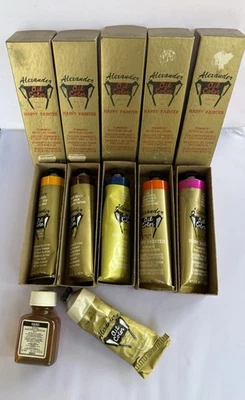Artists' Oil Paint
Shop by category
7,384 results
Sort: Best Match
- $500.00or Best Offer$9.00 shipping13 watching
- Authorized Dealer - Full USA WarrantyBrand New · Bob Ross$249.95Was: $299.99was - US $299.99Free shipping13 watching
- Brand New · Old Holland$315.00Free shipping
- Brand New · Royal Talens$45.00$6.98 shipping
- $37.95Free shipping236 sold
- Brand New · Gamblin$159.00Free shipping
- $15.45Free shipping253 sold
- $8.35 to $14.50Free shipping476 sold
- $17.95Free shippingOnly 2 left
- Brand New · Jack Richeson$6.00 to $7.50Free shipping
- Brand New · Winsor & Newton$219.00$34.25 shipping
- $19.15Free shipping245 sold
- Brand New · Gamblin$200.00$5.00 shipping
- Pre-Owned · Grumbacher$52.95or Best Offer$9.80 shipping
- Brand New · Royal Talens$68.00$8.98 shipping13 watching
- $79.99or Best Offer$30.00 shipping
- Pre-Owned · Winsor & Newton$30.00Free shipping
- $60.00$5.00 shipping
- $250.00or Best Offer$23.75 shipping
- $8.35 to $15.45Free shipping254 sold
- $8.35 to $15.45Free shipping234 sold
- Brand New · Gamblin$64.99Free shippingOnly 1 left!
- Brand New · Bob Ross$48.00or Best Offer$10.67 shipping
- Brand New · Gamblin$264.99or Best OfferFree shipping
- Brand New · Grumbacher$99.99or Best Offer$5.24 shipping
- Brand New · Gamblin$179.99Free shipping
- Pre-Owned · Bob Ross$36.00$9.04 shipping6 bids14h 32m
- Brand New · Gamblin$8.00 to $22.00$7.00 shipping27 sold
- $10.95 to $14.50Free shipping320 sold
- $8.35 to $14.50Free shipping185 sold
- $11.90Free shipping339 sold
- Brand New · Winsor & Newton$40.00Free shipping
- Brand New · Daler-Rowney$29.95Free shipping
- $14.99Free shipping92 sold
- Brand New · Gamblin$40.95$22.10 shipping19 watching
- $81.00$17.05 shipping3 bids2d 8h
- $1.95 to $69.95$5.90 shipping
- $69.99or Best Offer$14.45 shipping
- All but one tube has never been opened.Pre-Owned · Sennelier$48.00$9.95 shipping
- Pre-Owned · Unbranded$98.50$39.46 shipping80 watching
- $11.00$5.09 shipping1 bid5h 8m
- $24.00Free shipping195 sold
- Brand New · Gamblin$69.99Free shipping
- $25.08Was: $27.72was - US $27.72Free shipping277 sold
- $8.50Free shipping
- Brand New · WILLIAMSBURG$679.99Was: $720.99was - US $720.99Free shipping
- Pre-Owned · DaVinci$8.39$6.73 shipping0 bids5h 38m
- Brand New · Gamblin$150.00$5.00 shipping
- Brand New · U.S. Art Supply$16.99Free shipping440 sold
- $41.00$9.80 shipping0 bids10h 32m
- Brand New · Winsor & Newton$28.95Free shipping20 watching
- Pre-Owned · Bob Ross$39.95$13.28 shipping
- $40.00Free shipping
- Pre-Owned · Winsor & Newton$14.99$7.99 shipping
- Brand New · WILLIAMSBURG$359.99$5.00 shipping
- $13.99Free shipping207 sold
- Brand New · U.S. Art Supply$29.99Free shipping264 sold
- $9.95 to $49.95$7.90 shipping
- $19.95or Best Offer$7.45 shipping
- Brand New · Winsor & Newton$40.00or Best Offer$8.00 shipping













































































